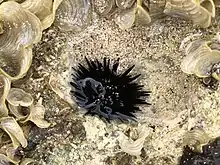| Echinometra oblonga | |
|---|---|
 | |
| Scientific classification | |
| Domain: | Eukaryota |
| Kingdom: | Animalia |
| Phylum: | Echinodermata |
| Class: | Echinoidea |
| Order: | Camarodonta |
| Family: | Echinometridae |
| Genus: | Echinometra |
| Species: | E. oblonga |
| Binomial name | |
| Echinometra oblonga Blainville, 1825 | |
| Synonyms[1] | |
| |
Echinometra oblonga, also called the oblong urchin or 'ina 'ele 'ele (ina= generic name for urchin, 'ele 'ele= blackish) in Hawaiian, is a very common rock boring urchin on shallow rocky shores of the tropical Indo-Pacific and Southern Africa.[2]
Description
Echinometra oblonga shows a range of color from dark purple to black. Their spines are shorter, and more blunt than other species of Echinometra.[3]
Reproduction
Echinometra oblonga, are gonochoric.[4] They fertilize externally. Their eggs are either held on the peristome or around the periproct.[4]
Habitat
Echinometra oblonga generally live in rougher-water areas of tropical reefs.[2] To protect themselves from the force of the waves, they live in the holes of the reef, but they also live on exposed reef flats.[2] As the urchin grows, they use their jaws to help enlarge holes in the reef. Their spines trap seaweed and algae from the reef, which they then transfer to the mouth.[2]
References
- ↑ Kroh, A.; Mooi, R. (2021). "Echinometra oblonga". WoRMS. World Register of Marine Species. Retrieved 30 September 2021.
{{cite web}}: CS1 maint: multiple names: authors list (link) - 1 2 3 4 Russo, AR (1977). "Water flow and the distribution and abundance of echinoids (genus Echinometra) on an Hawaiian Reef". Marine and Freshwater Research. 28 (6): 693. doi:10.1071/mf9770693. ISSN 1323-1650.
- ↑ McClintock, James B. (2019-10-22). "Disappearance of the rock-boring urchin Echinometra lucunter (Echinoidea: Echinodermata) in urchin-burrows along an extensive rock wall of Grotto Beach, San Salvador, Bahamas". Caribbean Journal of Science. 49 (2–3): 290. doi:10.18475/cjos.v49i2.a16. ISSN 0008-6452. S2CID 204811131.
- 1 2 "Echinometra oblonga, Short-spined black urchin". www.sealifebase.ca. Retrieved 2022-02-18.